 |
 |
|
 |
 |
List of visits during 2016
175 - Archaeological Ensemble of the Bend of the Boyne
A wonderful visit to a remarkable site. Such a impressive construction made so long ago with minimum af tools.
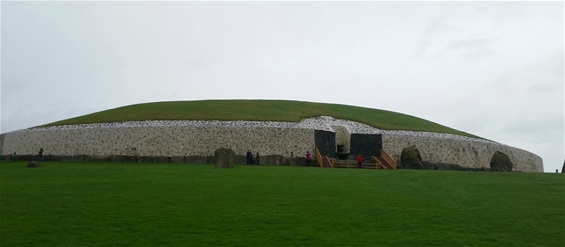 Newgrange
Newgrange
176 - Historic Centre of Macao
Had some trouble getting here with fog in Hong Kong. Arrived 2 hrs later than planned so it turned out to be a quick visit. It was really worth the time to come here. The old Portugese parts of this city was really amazing. Quite odd to think you are
in an european city but still you are in Asia
177 - Old Town of Segovia and its Aqueduct
The aqueduct in Segovia is truly a remarkable piece of engineering and building.
178 - Old Town of Ávila with its Extra-Muros Churches
The city wall is really so well preserved. When walking here you almsot feel that it could have been built yesterday.
179 - Canterbury Cathedral, St Augustine's Abbey, and St Martin's Church
This was another Cathedral visit. It feels like I have seen them all now. The good thing about Canterbury is that is so much more there to see. I really liked walking around the small church at St Martin´s. The church was really packed with history
dating way back. Not so crowded either so you could enjoy it.
180 - Kernavė Archaeological Site (Cultural Reserve of Kernavė)
This was a site to remember due to it´s beautiful suroundings. Beautiful weather and no people around made it sooo relaxing. Here they have found evidence of human activities during a period of 15 000 years. There is a relly good museum that displays
many artifacts that they have found during the escavations.
181 - Vilnius Historic Centre
After have being to the other Baltic capitals, Tallin and Riga it was time for Vilnius. This city is really a mix of evrything from beautiful to ugly. Most of the time it is beautiful and it is really nice to walk around and discover this city.
182 - Christiansfeld, a Moravian Church Settlement
This is really a remarkable little town. It is well preserved and you can understand how it was back in time when it was built.
183 - The par force hunting landscape in North Zealand
I had the opportunity to visit both the Store Dyrehave and Jaegersborg Dyrehave.
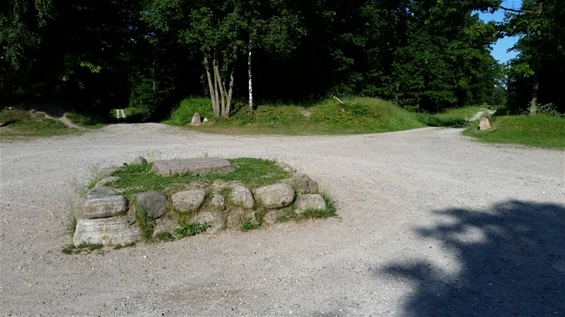 Stjernen i Store Dyrehavet
Stjernen i Store Dyrehavet
184 - City of Verona
A nice city with it´s Arena in the middle of the town. A lot more to find if you stroll around in this city
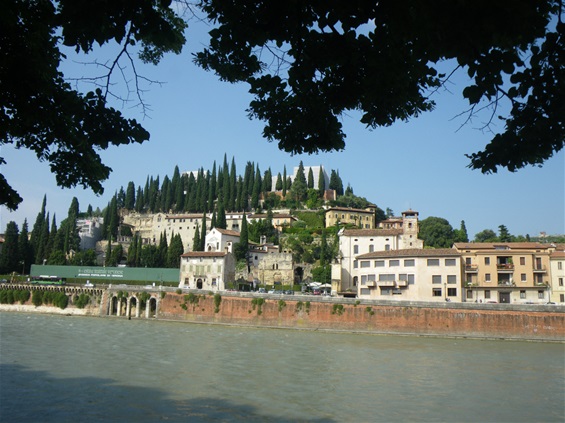 A nice view
A nice view
185 - Mantua and Sabbioneta
Mantova has a lot to offer. Not so many tourists here and fantastic buildings and suroundings.
186 - Cathedral, Torre Civica and Piazza Grande, Modena
Modena is a city with a lot to offer.
187 - Ferrara, City of the Renaissance, and its Po Delta
I had just 1 hour in this city between changing trains. It was worth the short stop over
188 - Medici Villas and Gardens in Tuscany
I ended up my trip in Florence and made a visit to Giardino di Boboli. At 35 degrees you still could find some nice shadows in this magificient garden. It is a landscape garden with trees and busches but limited number od flowers.
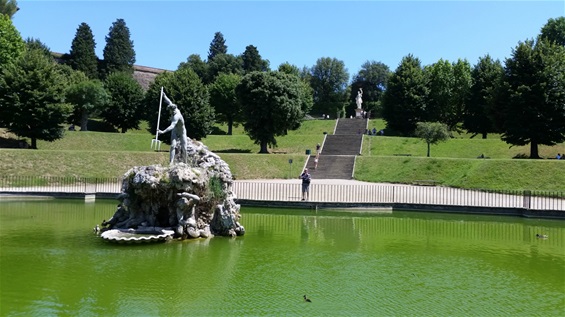 Giardino di Boboli - Neptune
Giardino di Boboli - Neptune
189 - Bronze Age Burial Site of Sammallahdenmäki
We made a really nice 1,5 km walk around these cairns from the early bronze age, 1300-1000 BC. There are 36 cairns within the World Heritage site but what makes this site unique is the flat, floor like "Church Floor" and the wall like "Long Ruin
of Huilu" Due to the remote location the site has been preserved almost intact in the original natural landscape without recent constructions such as houses, roads or power lines.
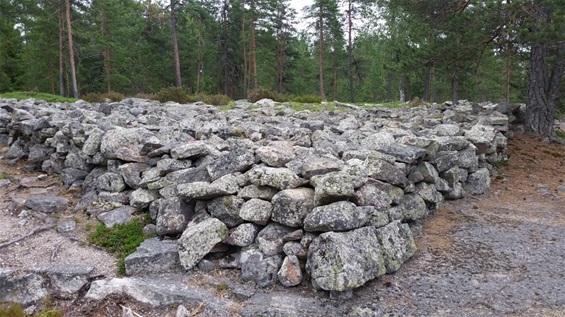 The "Church Floor"
The "Church Floor"
190 - Old Rauma
After we have visited Uusikaupunki with a lot of old wooden houses we went to Rauma to see some more. There are around 600 buildings in the 29 hectare area comprising Old Rauma. The narrow streets of Old Rauma follow lines set down in the Middle
Ages and are lined with houses, the oldest parts of which were built in the 18th century. It reflects the golden ages of sailing ships in the 1890s. At the time, many of the buildings on the main street were adorned with neo-renaissance facades
191 - Petäjävesi Old Church
The church was built in 1763-65 and the belfry and the corridor connecting the church hall to the belfry were built in 1821. Timber walls and the high barrel vaults are left unpainted but the tie-beams and the vault ribs are decorated with red
ochre paint following the medieval tradition of decoration. The interior of the church has remained almost original and there has never been heating in the church.
192 - Verla Groundwood and Board Mill
The Groundwood mill as it looks today is from 1882 except for the drying building in wood that was destroyed in a fire and was replaced by a red brick building in 1892. The main product of the factory was white mechanical pulp board, which was
manufactured at different strenghts until 18th July 1964. Going on the guided tour was a real pleasure. It started with a documentary film from the last days of operation in 1964 and then you could understand the different "stations" in the process
when you saw the intact factory during your walk. This was really a top visit 🙂
193 - Painted Churches in the Troodos Region
I made a visit to the Timios Stavros church in the beautifully situated village of Pelendri. The church of Timios Stavros is situated in a central area of the Troodos mountain range, at the south end of the village of Pelendri, which is
attested in the sources since the late 12th century. The main part of the church of Timios Stavros was decorated during the second half of the 14th century. At least two artists belonging to the same workshop were involved, together with
their students. Many donors contributed towards this decoration complex. From these wall-paintings we can distinguish a group which follows the Palaiologan style developed in Constantinople during the 14th century. A second group follows the contemporary local
Byzantine tradition, enriched with crusader and Armenian features, both in terms of the style and iconography. I can only recommend a visit to the Troodos region, it is really worth the visit. In summer you will enjoy the cooler climate
up here 🙂
194 - Choirokoitia
Only 35 minutes away from Larnaca I had a visit to this interesting area. No crowds at all so you really could make it at your own speed. The site of Choirokoitia, which was founded and inhabited during the 5th millennium B.C., was discovered
in 1934. The site is bound to the north, east and southeast by the deep bend of the river, and to the west by successive walls. A complex architectural system, unique in Cyprus and the Near East, provided control over access to the village. Protected
by these walls, the houses of the settlement were crowded together. A house consisted of a compound of several buildings with a circular ground plan around an unroofed space, a kind of small inner “courtyard” where grinding took place. These structures
were built in stone, pisé and sun-dried mudbrick, or any combination of the three. The roof was flat and consisted of a wooden frame made out of branches, reeds, pisé and earth. Excavation revealed that the dead were buried in pits inside the
dwelling units. The brilliant civilisation vanished suddenly, and no adequate explanation has been given regarding its disappearance. Choirokoitia, like other aceramic sites on the island, was abandoned and the island appears to have remained free from
human presence for a long time, until the emergence of a new civilisation: the Ceramic Neolithic.
195 - Paphos
On a hot and sunny day I walked around this area and the most memorable this sight will bring to you is all the remarkable mosaics. Now some background information. Nea Pafos is situated on a small promontory on the southwest
coast of the island. According to written sources, the town was founded at the end of the 4th century by Nicocles, the last king of Palaipafos. In the beginning of the 3rd century B.C. when Cyprus became part of the Ptolemaic kingdom, which had its capital
in Alexandria, Nea Pafos became the center of Ptolemaic administration on the island. Until the end of the 2nd century B.C., Nea Pafos acquired such an important role as a political and economical centre of the region that the Ptolemies made it the capital
of the whole island. When in 58 B.C. Cyprus was annexed by Rome, Nea Pafos continued to be the capital of Cyprus. The House of Dionysos: This rich building belongs to the Greco-Roman type where the rooms are arranged around a central court,
which functioned as the core of the house. It seems that the house was built at the end of the 2nd century A.D. and was destroyed and abandoned after the earthquakes of the 4th century A.D. The House of Dionysus occupies 2000sq. metres of which 556 are covered
with mosaic floors decorated with mythological, vintage and hunting scenes. At the House's entrance these is a pebble mosaic representing the mythical sea-monster Scylla that belonged to a Hellenistic building found below the later Roman one.
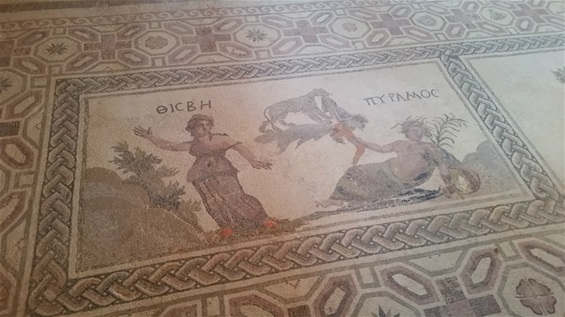 Pyramos and Thisbe from the House of Dionysos
Pyramos and Thisbe from the House of Dionysos
196 - Castle of the Teutonic Order in Malbork
I had a fantastic day at this site. Good weather and that created a lot of people around. I visited the Visitors Center and paid the entrance fee that included an audio guide. The 2,5 hrs tour following the guide took me around almost all of the area.
I ended up with strolling around on my own for an hour to enjoy the site. The visit was better than my expactations. This site has really experienced a lot since it was constructed. Malbork Castle is the most complete and elaborate example of the Gothic
brick castle complex in the characteristic and unique style of the Teutonic Order, which evolved independently from the contemporary castles of western Europe and the Near East. The spectacular fortress represents the phenomenon of the monastic state in Prussia,
founded in the 13th century and developed in the 14th century by the German communities of military monks who carried out crusades against the pagan Prussians on the south Baltic coast. The fortified monastery on the River Nogat represents the drama of Christianity
in the late Middle Ages, stretched between extremes of sanctity and violence. Over a span of two hundred years, since the 18th Century, the Malbork Castle has remained one of the major objects of European fascination with medieval history and its material
remains. It also became a sign of the tendency to treat history and its monuments as instruments in the service of political ideologies. From the 19th century onwards Malbork Castle has been the subject of restoration that contributed in an exceptional
way to the development of research and conservation theory and practice. At the same time many forgotten medieval art and craft techniques were rediscovered. Extensive conservation works were carried out in the 19th and early 20th centuries. Following the
severe damage that it incurred in the final stage of World War II, the castle was restored once again.
197 - Curonian Spit
On a beautiful day I had the opportunity to walk around the small village of Nida. It was really something special with the high sand dunes in the background. This place was one of the most relaxing places I have ever been to. I will för sure go
back to Nida just to enjoy the peacefulness. The Curonian Spit is a unique and vulnerable, sandy and wooded cultural landscape on a coastal spit which features small Curonian lagoon settlements. The Spit was formed by the sea, wind and human
activity and continues to be shaped by them. Rich with an abundance of unique natural and cultural features, it has retained its social and cultural importance. Local communities adapted to the changes in the natural environment in order to survive. This interaction
between humans and nature shaped the Curonian Spit cultural landscape.
198 - Al Zubarah Archaeological Site
At this time of the year it is so nice to go to places with a lot of sun. Qatar was a place I had never been to so off we went. The Fort we visited was well restored, maybe to well. Anyhow the exhibitions in the Fort was really well done. A lot of interesting
facts about the area. Not one of the most exciting visits, but at least another country ticked off. The walled coastal town of Al Zubarah in the Persian Gulf
flourished as a pearling and trading centre in the late 18th century and early 19th centuries, before it was destroyed in
1811 and abandoned in the early 1900s. Founded by merchants from Kuwait, Al Zubarah had trading links across the Indian Ocean, Arabia and Western Asia. A layer of sand blown from the desert has protected the remains of the site’s palaces, mosques, streets,
courtyard houses, and fishermen’s huts; its harbour and double defensive walls, a canal, walls, and cemeteries.
199 - Pearling, Testimony of an Island Economy
After some problem to explain to the taxidriver where we wanted to go we arrived in the area we intended to visit. I had a detailed plan of the different buildings included in the sight with me so we could take an walk between the most interesting houses.
Some were in really poor condition and others where just now under renovation. We had the opportinity to sneek in to the courtyard of one of the most interesting houses, that just was under renovation. The site consists of seventeen buildings
in Muharraq City, three offshore oyster beds, part of the seashore and the Qal’at Bu Mahir fortress on the southern tip of Muharraq Island, from where boats used to set off for the oyster beds. The listed buildings include residences of wealthy merchants,
shops, storehouses and a mosque. The site is the last remaining complete example of the cultural tradition of pearling and the wealth it generated at a time when the trade dominated the Gulf economy (2nd century to the 1930s, when Japan developed cultured
pearls). It also constitutes an outstanding example of traditional utilization of the sea’s resources and human interaction with the environment, which shaped both the economy and the cultural identity of the island’s society.
200 - Qal’at al-Bahrain – Ancient Harbour and Capital of Dilmun
My visit number 200 !!!! A time to remember. The area is really worth a visit. During a long time this site has been inhabited by humans. In the exhibitions you cna learn a lot about what has happened here during the years that have passed. We spent
several hours here to explore the sight that was really worth a visit. Qal’at al-Bahrain is a typical tell – an artificial mound created by many successive layers of human occupation. The strata of the 300 × 600 m tell testify
to continuous human presence from about 2300 BC to the 16th century AD. About 25% of the site has been excavated, revealing structures of different types: residential, public, commercial, religious and military. They testify to the importance of the site,
a trading port, over the centuries. On the top of the 12 m mound there is the impressive Portuguese fort, which gave the whole site its name, qal’a (fort). The site was the capital of the Dilmun, one of the most important ancient civilizations of the
region. It contains the richest remains inventoried of this civilization, which was hitherto only known from written Sumerian references.
201 - San Cristóbal de La Laguna
A nice visit to a quiet town. A lot of nice buildings with fantastic courtyards behind the facades. Many of the buildings are painted in bright colours which makes it special. Not something you usually see in s spanish town. San Cristóbal
de La Laguna, in the Canary Islands, has two nuclei: the original, unplanned Upper Town; and the Lower Town, the first ideal 'city-territory' laid out according to philosophical principles. Its wide streets and open spaces have a number of fine churches and
public and private buildings dating from the 16th to the 18th century.
|
|
 |
|
|
|